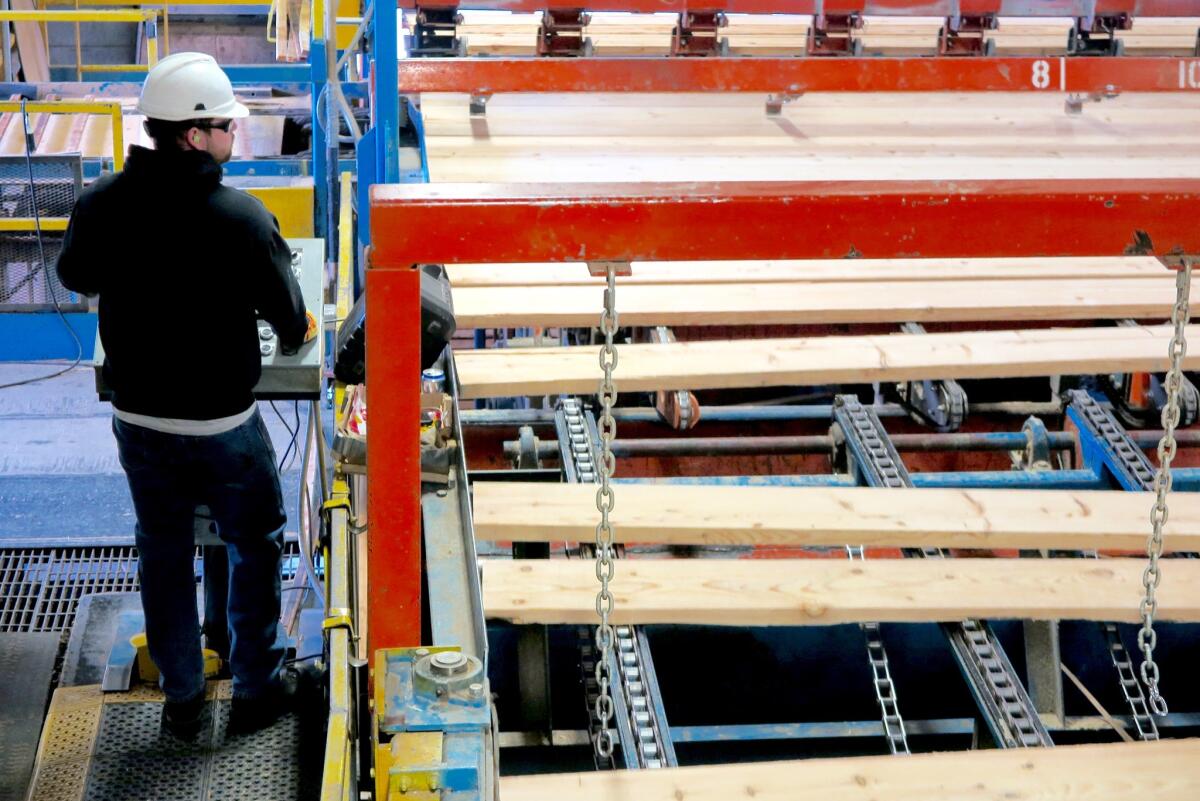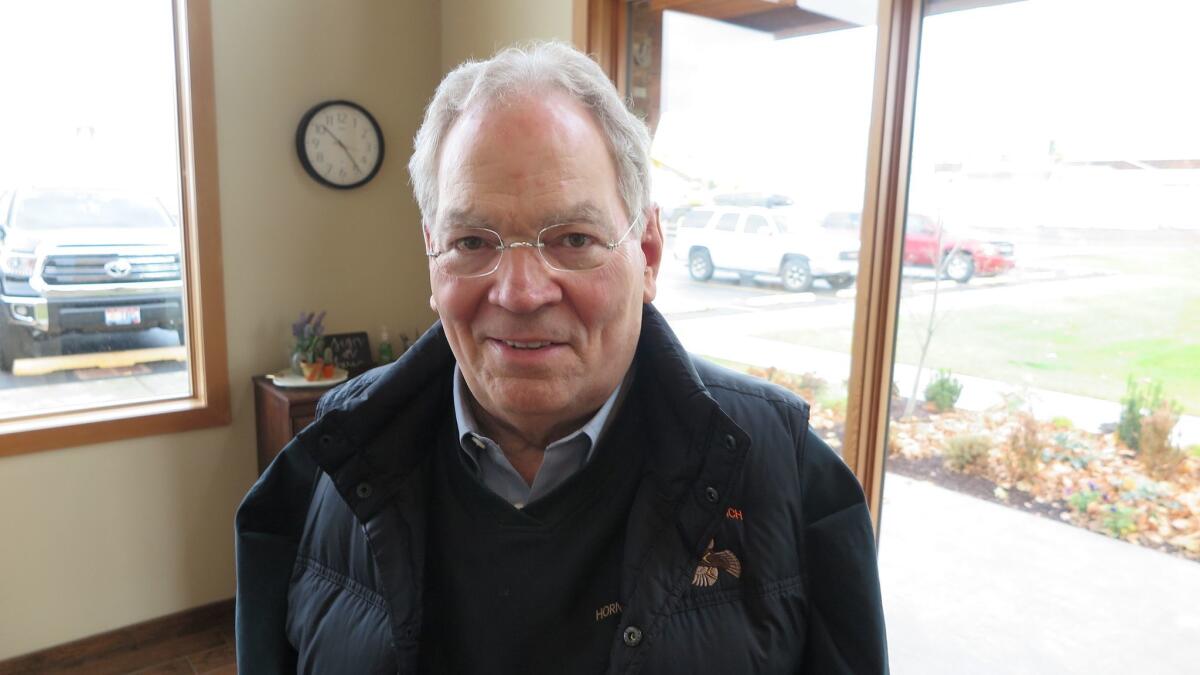Trump called for a ‘truly representative process’ for managing public land. One already exists in Idaho

Reporting from Lewiston, Idaho — President Trump flew to Salt Lake City this month to remove 2 million acres from two national monuments in Utah, and to rebuke “distant bureaucrats” for acting to safeguard the West’s public domain without adequately consulting neighboring communities.
“Under my administration, we will advance that protection through a truly representative process,” said Trump, “one that listens to the local communities that know the land the best and that cherishes the land the most.”
Though the president’s critics questioned the administration’s fealty to more inclusion in managing the West’s natural bounty, one place that the president and his aides could look for a model of a “truly representative process” is how former foes have cooperated to manage millions of acres of national forest land in Idaho.
“We do things a little different here,” said Rick Johnson, executive director of the Idaho Conservation League, Idaho’s largest state-based environmental group. “In north Idaho, the timber industry is doing well. They are putting logs in those mills. They need us to get stuff done and we need them.”
“Agreed,” said Marc Brinkmeyer, the founder and owner of the Idaho Forest Group, the state’s largest timber company. “They tell us they want more wilderness protection. We tell them we want certainty of supply. We found a way to do both.”
But in an era riven by ideological division, participants say a nearly decade-old program fostered by the U.S. Forest Service to form multi-stakeholder groups, called “collaboratives,” is under pressure from powerful political influences in Washington and Idaho.

“It’s delicate. We’ve managed until now to make collaboratives work well,” said Brad Brooks, director of the Wilderness Society’s national public lands campaign, who lives in Idaho. In 2008, he helped form the Clearwater Basin Collaborative, one of nine such groups that assist the Forest Service in managing Idaho’s 20.2 million acres of federal forest, more than in any state except Alaska and California.
“We are not focused on picking fights with people,” he said. “We realize that there is opportunity when we work on the things we agree on.”
In 2009, a budget bill approved by Congress directed $40 million a year for 10 years to fund projects that enable an array of interest groups to assist the Forest Service in developing timber management projects.
Three of the 23 collaboratives in 14 states that Congress funded are in Idaho. California and Oregon also each have three federally funded collaboratives. The groups are intended to reduce the considerable civic friction in timberland management programs.
In the last eight years, Idaho’s collaboratives helped the Forest Service design and execute projects that restored big stretches of degraded forest, removed hundreds of old roads, and repaired miles of wild stream banks. Participants, who meet regularly with Forest Service staffers, include county and state government officials, industry executives, Native Americans, environmentalists, recreational industry representatives, hunting and fishing groups, and off-road vehicle organizations.
Keith Lannom, supervisor of the 2.3-million-acre Payette National Forest, said collaboratives had helped cut the time needed to complete a forest restoration plan from four years to two, and increased the size of the forest projects from roughly 3,000 acres to as many as 80,000 acres.
“All the different groups that participate in a collaborative and reach agreement go a long way toward getting a project implemented,” Lannom said. “They’ve been very helpful.”
Federal law requires the Forest Service to carefully evaluate the ecological consequences of any major action to repair damaged timber land, cut trees, remove roads, and take other management measures on parcels of national forest. The collaboratives advance the process by removing features that are sure to invite challenges and delays — like proposing new roads in a roadless area.
An apt example of the groups’ work is how the Forest Service this month completed a 50,000-acre restoration plan for the Payette National Forest with the help of the Payette Forest Coalition, a collaborative formed in 2009. The land management plan, the third collaborative project developed on the Payette forest, calls for logging select areas, removing 76 miles of roads, applying prescribed fire techniques to 27,000 acres, and restoring the banks along 55 miles of streams.
Timber trucks dropping loads of 50-foot logs, and the screaming blades of the Idaho Forest Group’s state-of-the-art sawmill here on the banks of the Clearwater River, are more evidence of collaborative benefits. The number of board feet of timber cut from the Payette and Idaho’s other national forests has almost doubled to 178 million since collaboratives got started. The Idaho Forest Group’s executives participate in a number of collaboratives that encourage ecologically sensitive logging practices, which helped it grow into the nation’s eighth-largest timber company.
“If diverse points of view get together, there is very little in this world that we can’t solve,” said Rep. Mike Simpson (R-Idaho), a champion of public land safeguards.
Collaboration isn’t always successful. A congressional collaborative initiative started in 2010 by former Utah Sen. Bob Bennett to protect public land in southeast Utah fell apart after five years, prompting five Native American tribes to pursue safeguards for the 1.35-million-acre Bears Ears National Monument. President Trump, acting at the request of Utah’s congressional delegation, removed 1.1 million acres from the monument this month.
Idaho, one of the wildest states in the country, is an apt place for once-warring factions to reach a truce. Years of ferocious conflict in the 1980s and 1990s over endangered salmon and trout, old growth forests, wild stream protection, and building roads in roadless areas caused deep psychic scars.
From a peak of 809 million board feet of timber felled in Idaho’s national forests in 1990, timber cuts plummeted nearly 90% to 92 million board feet in 2006, according to Headwaters Economics, a Bozeman, Mont., research group. Sawmills closed. Environmental damage left the state’s public forests more vulnerable to insects, erosion and drought, which dried underbrush and fueled wildfires.
The Forest Service has determined that about a third of the 188.3 million acres it manages in 154 national forests across the country are severely degraded. Idaho Forest Group executives assert that improving the condition of national forests is closely linked to cutting more trees. Some 7 million acres of Idaho’s national forest are eligible for logging — especially where trees were affected by forest fires or are growing on land that has already been logged.
Idaho’s collaboratives support cutting more trees, which has helped Brinkmeyer build Idaho Forest Group into an industrial powerhouse with six mills and 1,000 employees. Roughly 20% of the logs needed to manufacture the 1.2 billion board feet of lumber that the Idaho Forest Group produced this year comes from federal forests, double the amount five years ago. Idaho Forest Group is one of the nation’s top five buyers of national forest timber.
“We have an Idaho timber company coming into its own,” said Rick Johnson of the Idaho Conservation League. “We have adult conversations about how to move things forward that are good for Idaho’s economy and environment. It’s confusing for some people who are still locked into the old framework. Timber cutting bad. No logging good. People here have moved on. We found common ground.”
Follow Keith Schneider, Western environment and public lands correspondent, on Twitter.
More to Read
Sign up for Essential California
The most important California stories and recommendations in your inbox every morning.
You may occasionally receive promotional content from the Los Angeles Times.










